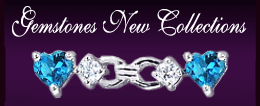Glittering Stones » Gemstone Reports »Gemmological Institute of Thailand Lab Report (GIT)
Gemmological Institute of Thailand

Established in 1931, the nonprofit Gemological Institute of America (GIA) is one of the world's foremost authorities in gemology.
GIA's mission is to ensure the public trust in gems and jewelry by upholding the highest standards of integrity, academics, science, and professionalism through education, research, laboratory services, and instrument development.
Although plans are in-hand to expand GIA Laboratory operations to other parts of the world, GIA Research (Thailand) (GRT) is presently the only fully operational GIA Laboratory outside the United States of America. In addition to the ongoing research function GRT supports both the local and international colored gemstone community by examining and issuing reports on all colored gemstones and pearls. Following the expansion of GRT’s premises, in early 2008 GIA diamond grading will be added to the list of services available in Thailand.
Identification Report:
Identification reports professionally document the results of a full examination of a gemstone. The results explains and identify the gemstone examined produced such identifying characteristics as; color, transparency, shape, cut, dimensions, weight and a color photo. The full report will also specifies whether it is natural or synthetic and if the gemstone has been treated to enhance its appearance by an identifiable treatment. It will also be noted if it is a stimulant with no known natural counterpart, or if it has been assembled from two or more separate components.
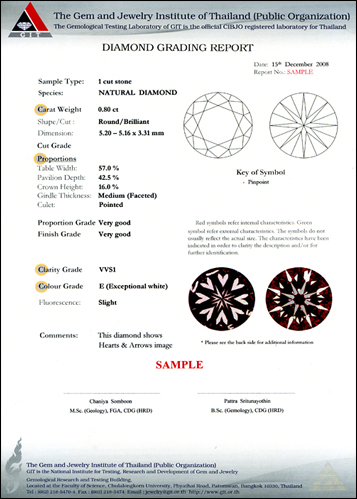
Diamond Grading Report:
The report indicates the variety, type, proportion, weight and the clear description including the quality of the diamond according to the 4Cs (Color, Clarity, Cut and Carat).
Wonder of Nature:
There is no other gemstone quite like a diamond. It is found in the most remote places on earth, and the fact that it forms at all is something of a miracle. It takes about one ton of rock to recover less than half a carat of rough, making diamond one of the rarest and most desired gemstones in the world.
A diamond is a testament of endurance and strength – and not surprisingly, the ultimate symbol of love.
Treasure of Time:
Each and every diamond is unique. Each diamond reflects the story of its arduous journey from deep inside the earth to a cherished object of adornment. Yet all diamonds share certain features that allow us to compare and evaluate them. These features are called the 4Cs.
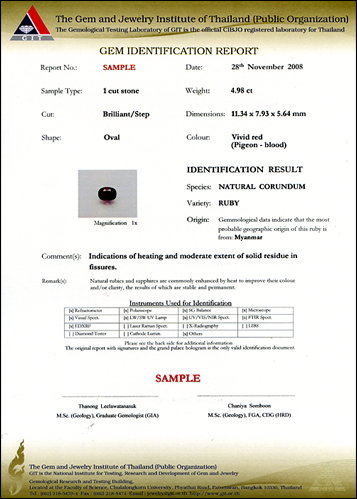
Gem Identification Report:
Gem Identification Report indicates variety, type, proportion, weight and full description including a digital photograph of the gemstone.
Quality grading for color, clarity and cut is available for ruby and sapphire.
The details and photograph of the gemstone are printed on a special type of paper which bears a three-dimensional hologram sticker with an image of the Grand Palace to prevent counterfeiting. Each report is signed by two gemologists.
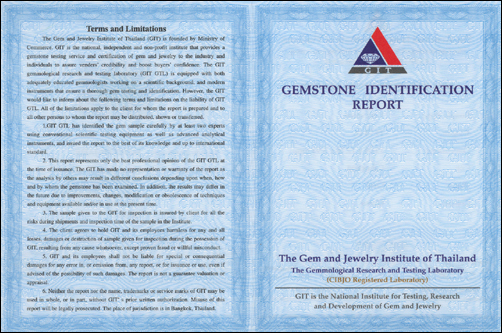
Mini Report:
The report indicates variety, type, proportion, weight including a brief description.
The report is in pocket-size which makes it easy to carry and to display with the jewelry in a showcase. The service has been available since 1st January, 2002.
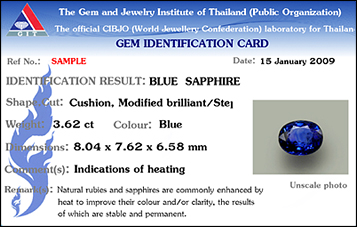
Gem Identification Card
Gem identification card indicates variety, type, proportion, weight and brief description of the gemstone.
It easy to carry and to display with the jewelry in a showcase. The service has been available in July, 2008.
4Cs of GIA (Thailand):
The 4Cs provide a way to objectively compare and evaluate diamonds, but numbers alone can’t describe a diamond’s mysterious and captivating beauty – for that, you’ll have to visit your local jeweler to see one for yourself.
Color:
Color grades are determined by comparing each diamond to a master set. Each letter grade represents a range of color and is a measure of how noticeable a color is.
Some diamonds can emit a visible light when exposed to ultraviolet radiation, but fluorescence is not a factor in determining color or clarity grades. However, a description of its strength and color is provided on GIA Reports as an additional identifying characteristic.
Clarity:
The GIA Clarity Scale includes eleven clarity grades ranging from Flawless to I3.
Because of diamonds form under tremendous heat and pressure, it is extremely rare to find a diamond that lacks any internal and external characteristics. These characteristics are a by product of its formation and help the gemologists separate the natural diamonds from the synthetics and stimulants, and then identify individual stones.
Cut:
The GIA Cut Scale ranges from Excellent to Poor. A polished diamond’s beauty lies in its complex relationship with light: how light strikes the surface, how much enters the diamond, and how, and in what form light returns to your eyes.
Carat Weight:
One carat equals 200 milligrams in weight. For diamonds under one carat, each carat is divided into 100 points – similar to pennies in a dollar. 0.75 ct. = 75 points? ct. = 50 points.
Other Gem Stone Report:
Quality Assurance:
Quality Assurance Reports (QARs) are communicated in a spreadsheet or label and detail only the specific information requested.
Sorting
Batch Testing
Prelims
On-Site Consultancy:
Visits are prearranged visits by GIA gemologists to business offices or to homes of individuals who require gemological advice. This advice will be gemological in nature but may or may not involve the examination of actual stones.
NOVEMBER BIRTHSTONE - CITRINE
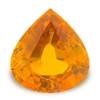
COMMEMORATIVE EVENT - 13th Anniversary
KEYWORDS - Success, Abundance, Personal Power
ALSO KNOWN AS - Merchant's stone, Success stone
COLORS - Pale yellow to brown
OCCURRENCE - Brazil
COLOR ZONING - Tiger stripes or Zebra stripes


